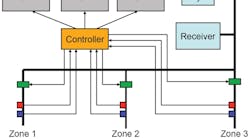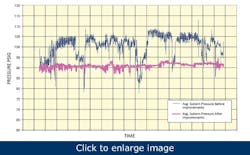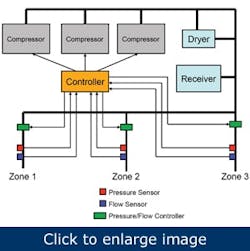In brief:
- Using the proper compressed air control system can maximize the efficiency of a plant’s compressed air operations and avoid unnecessary costs of electricity and maintenance.
- Compressors should be chosen by a central control system based on the efficiency of the individual compressors, compressed air demand, production loads, and maintenance schedules.
-
Simply monitoring the pressure of the air supply at various places around the plant isn’t enough to use in determining when to start additional compressors.
Compressed air generation represents roughly 10% of the total energy consumed by manufacturing plants in the United States, according to “Energy Tips” from the U.S. Dept. of Energy (DOE), Office of Industrial Technologies. A significant amount of that is wasted by plants whose compressors aren’t being used efficiently, whose air supply networks have leaks that aren’t being attended, or those with poorly designed distribution systems. At its best, compressed air is a relatively inefficient source of power. For each dollar’s worth of electricity going into producing compressed air, the factory is getting only 10-15% usable energy in return, compared to other power sources such as electric motors, which are typically 80-95% energy-efficient, according to the DOE Office of Energy Efficiency & Renewable Energy’s “Buying An Energy Efficient Motor.”
Using the proper compressed air control system can maximize the efficiency of a plant’s compressed air operations and avoid unnecessary costs of electricity and maintenance.
In the old days, when compressed air systems were exclusively governed by mechanical pressure switches and gauges, systems would often be operated at an unnecessarily high pressure in an attempt to avoid low-pressure conditions and provide the flow needed by the production process. This contributed to leaks and potential premature system component wear-out, also resulting in higher costs. And, of course, because energy cost is directly related to the level of pressure, running a plant at a pressure that is higher than necessary also results in higher energy costs than necessary.
There are costs associated with running systems too conservatively, as well. A plant might have compressors running at only part of capacity due to incorrect local pressure settings that go unnoticed. In that case, it may have seemed much easier for plant managers to buy more compressors to solve low-pressure problems.
Control systems that perform cascade sequencing are a step beyond mechanical pressure controls. But these systems, where compressors are brought on line one at a time as the need for more flow increases, are prone to producing a large pressure band — the pressure in the system can vary significantly depending on the number of compressors that are on line at any given time. Not only is that an inefficient way to operate a factory’s compressed air resource, but energy can be wasted unnecessarily in the rigid sequential way that the compressor bank is controlled.
Game plan for better controls
A better way is to select which compressors to use based on multiple factors. Instead of having just a rigid order of compressors that come online, compressors should be chosen by a central control system based on the efficiency of the individual compressors, compressed air demand, production loads, and maintenance schedules.
A side benefit of a centralized control system is that it can record data and produce reports that may be used by factory executives to help plan for future capacity needs. And with the data, the cost of a factory’s compressed air resource can be quantified and rolled in with other costs of production to get a complete picture of the cost of production.
So what is the best way to manage compressor resources effectively and efficiently? As with basketball, there’s scoring involved. Just as a basketball team will score more points if managed correctly, proper management and control of a factory’s compressed air resources will save a company more money. The control system needs to consider multiple factors, including the efficiency of each compressor, its capacity, and its run time. Run-time scoring enables the controller to predict when the players on the floor (compressors in operation) should be replaced by players from the bench (compressors in reserve). As the controller monitors how long a particular compressor has operated, it develops a score that changes with time and how it’s been operating. Eventually a particular compressor’s score will hit a threshold where the system says,
“OK, you’ve run long enough,” and rotates another compressor in its place. Based on production information, this score can be adjusted by the control system to lengthen or shorten the compressor’s operating cycle.
When deciding which compressor to run next, the controller shouldn’t base that decision on efficiency alone, however. If that were the case, the system would tend to wear out the most efficient compressor. It would run all the time. So efficiency must be weighed with other factors.
For example, say that a particular compressor’s oil must be changed every 8,000 hours of operation. The controller keeps track of this schedule and as the compressor usage approaches 8,000 hours, the maintenance factor starts to affect the overall score that determines when that compressor will run.
[pullquote]The control system should also be able to accept user-defined inputs, which can affect the decision as to which compressor to run according to special factors known by the plant operators. This feature can be used to test out different control strategies. For example, a particular compressor may be called upon based on the requirements of a specific piece of production equipment and the proximity of the compressor. Or perhaps the “coach” wants to say, “I know that the regular scoring algorithm says that you (the compressor) are due for a break, but I’m going to insist that you stay in the game a little longer.”
Pressure monitoring isn’t enough
Simply monitoring the pressure of the air supply at various places around the plant isn’t enough to use in determining when to start additional compressors. With pressure monitoring only, by the time a controller detects a low-pressure situation and a compressor starts making air, the pressure might have dropped significantly below the setpoint to an undesirable level.
To protect against having the pressure drop below a certain minimum, possibly causing a malfunction of the production equipment, one could raise the threshold pressure at which additional compressors come on, but the effect of this is to run the compressed air system at an average pressure level that is higher than necessary. This wastes energy and may result in the factory purchasing and maintaining more compressors than it needs. Maintenance costs can also increase needlessly due to air leaks and compressor wear caused by running the system at too high of a pressure.
The solution is to monitor the flow of air, not just the pressure. With this additional data, the control system can predict when the pressure would cross the low-pressure threshold and use that information to start additional compressors, if necessary, and give them time to ramp up to speed before the pressure threshold is reached. The control system can also factor the production load into the control decisions that it makes.
Figure 1. The upper line reflects system pressure without active control. The lower line shows how the addition of a controller can smooth out the system pressure and enable the system to operate at a lower overall average pressure.
Figure 1 shows the beneficial effect of active compressor control. Controlling compressor operation using flow, pressure, and demand information avoids pressure spikes and enables the system to run at a much more stable pressure level that is lower than that of a system without active controls. As the diagram suggests, active control can reduce the energy consumption of compressed air systems by 15-40%.
Building networks of compressors
With the ability to monitor and respond to multiple air pressure and flow sensors comes the ability to also manage different pressure levels throughout a plant. A factory’s compressors and compressed air delivery systems can be organized into networks that may be optimized to use energy most efficiently and to provide backup air sources when needed. The control system can take inputs from certain zones of the plant, certain pieces of equipment, and production lines or machine centers. The system can provide just the right amount of air at just the right time to meet those needs. Zones supporting inactive production lines can be closed off. Figure 2 provides an example of the type of pneumatic network that can be constructed.
Figure 2. The controller can manage a network that supplies compressed air to different parts of the factory.
Active control capability can also allow for additional factors to be rolled into the control equation, beyond air pressure and flow. For example, the control algorithms can be adjusted to factor in the cost of electricity that might be different at different times during the day; or the strategies for selecting specific compressors to run can be changed over time as a factory’s production mix changes, proactively selecting a “recipe” that describes the compressed air resource that is required to serve a particular production run. Alternately, the mix of compressors needed to serve a particular work shift can be set up to support a specific maintenance strategy.
Intelligent controls can also help plant maintenance staff implement preventive maintenance programs. For example, these controls can monitor compressed air usage in a particular zone, making sure that one zone is not beginning to creep up versus that of other zones, which could be an indicator of a maintenance issue such as an excessive leak. Alternately, if the pressure in a zone decreases but production has not changed, the controller might suggest that a problem such as constriction in the lines due to corrosion or fouling is occurring.
One company’s experience
At 797,000 square ft, the Gatorade plant in Tolleson, Arizona, is the largest producer of Gatorade and Propel in the world, and use of compressed air is integral to its bottling process. After undergoing an independent compressed air analysis, several issues were identified with the compressed air system. The plant had seven compressors in three locations, but there was no monitoring in place to observe system-wide pressures. To ensure adequate air supply under all conditions, the compressors were operated at higher pressures than necessary, regardless of production requirements. “We suspected that energy was being wasted, but we didn’t know how much,” says Tom Schaefer, principal engineer — resource conservation for PepsiCo Gatorade (www.pepsico.com).
| Eric Bessey is chief engineer at Pneu-Logic. Email him at [email protected]. |
After undergoing a compressed air analysis by an independent consultant, plant managers installed a PL4000 control system by Pneu-Logic (www.pneulogic.com). The controller matched air supply with air demand using policies and patented control algorithms called Airgonomics. The controller allowed only one compressor to operate at a partial load at a time as a trim compressor. All other compressors were either off or operating at full load. As additional compressors were needed, they were always brought on at full load as the trim compressor continued to run at part load. The PL4000 uses flow-based compressor staging tables to select optimal compressor combinations to run.
Efficient compressor control was achieved at the Tolleson plant without altering the compressor’s native controls, allowing for manual override on any individual compressor. The on-the-fly override that is supported by the PL4000 allows for maintenance of a single compressor with no disruption of control to other compressors.
“The system was started and tuned for optimum performance quickly and while the plant was in full operation,” says Schaefer. By upgrading the plant’s compressed air system and installing the PL4000 compressed air controller, the total amount of energy required to run the compressed air system has been decreased by 21%, resulting in an annual savings of more than 1 million kWh of electricity and a 1.5-year payback on the project. “We got a system that is user-friendly, is expandable, and provides detailed information about the entire compressed air system that can be used for troubleshooting and energy reduction planning,” adds Schaefer.


